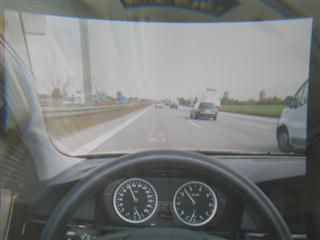Enabling Personalized Augmented Reality Display Technology in Cars
Subject
With recent advances of Head-up Display (HUD) technology in cars, Augmented Reality becomes interesting in supporting the driving task. At our lab, we have a driving simulator and are currently setting up a HUD with a tilted image plane. The image plane of a normal HUD appears to be vertical to the driver, while a conformal HUD has an image plane that lies on the street. So it is capable to provide depth based information.
Sketch of the planned contactanalog HUD (Courtesy of BMW, adapted)

Picture distored by a fresnel lense
Issues
Calibrate Aligned Rendering
Generate Projectionmatrix from eight viewpoints. That cube specifies the volume, head moves inside.Interpolate Dynamic Viewpoint Dependent Projection Matrix
Image Warping
Warp Rendered Image Distored by Fresnel Lense
Fresnel lense distortion in general is static, but dependent to viewpoint.Warp Rendered Image Distored by Windshield
Every windshield generates another distortion of the image.Incorporate Slope Sensor
-- MarcusToennis - 25 Jan 2007| ProjectForm | |
|---|---|
| Title: | Enabling Personalized Augmented Reality Display Technology in Cars |
| Abstract: | This thesis' focus resides on developing technologies that enable incorporation of AR techniques into cars to enable driver assistance systems. For this purpose the rendered virtual content is presented on a conformal Head-Up Display (HUD) that uses the car's windshield. The construction of the HUD introduces two major sources of distortion on the image that have to be overcome: lens distortion caused by the fresnel lens, which is used to stretch the distance between the driver's eyes and the focal plane of the HUD, and distortion due to the curved shape of the windshield. Every windshield is unique in its shape so first a calibration procedure that can extract the distortion parameters of any given windshield should be developed, and then distortion correction can be performed with the help of a piecewise projective warping function. A calibration procedure for fresnel lenses should also be implemented, and with its help the image can be undistorted by using a radial distortion warping function. Since the image distortion presented by a lens depends on the distance and position of the viewer with respect to the center of the lens, the driver's head position has to be taken also into account when developing the correction function. For tracking the driver's head we intend to use a 6DOF-Tracker, for example UbiTrack?. The tracked driver's pose is also needed for continuously adapting the projection and viewing matrix of the rendering process, so that virtual objects are always aligned in the physical world. |
| Student: | Michail Yordanov |
| Director: | Gudrun Klinker |
| Supervisor: | Marcus Tönnis |
| Type: | DA/MA/BA |
| Area: | |
| Status: | finished |
| Start: | 2007/11/15 |
| Finish: | 2008/07/15 |